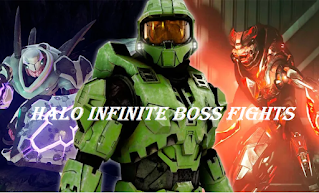How learned Halo Infinite boss fights from previous games
Halo infinite boss fights - Much more than mere bullet sponges with names, these boss fights show that 343 Industries is trying to crack one of the Halo series' biggest weaknesses. Halo Infinity is starting to show some great promise with its gameplay and design that seem to go back to the roots of the series' Bungie era, as well as the positive reception of free-to-play multiplayer (despite some controversial decisions about progression).
In addition to putting the Master Chief and his battles against the (ancient) Covenant races at the forefront once again, Infinity aims to evoke the images of the original Evolved Combat with its more open sandbox and freedom on how to approach combat encounters. But Infinity aims to add a host of new features to turn things around and wow players, including a new focus on boss fights.
A recent showcase for Infinite Halo This week's campaign featured two enemies Banished for the Master Chief to confront his strength and ingenuity: Engineer Brutus Trimonious and elite swordsman Chak’lok. His presence in Infinity reveals that they are unique versions of regular enemies with stronger shields, more health, and complex move sets that make the usual strategies against their standard enemy counterparts that much more difficult to pull off. Players must rely on the environment, their arsenal knowledge, and increased mobility to succeed against them.Also Read: How to beat chak lok Halo Infinite
The Halo series has had a tumultuous history with its boss fights, always striving to make one worthy of beloved enemy NPCs. Halo 1 had no discernible “boss fight” to speak of, with the climactic Warthog Run achieving a far more satisfying ending than any bullet sponge would have been. Bungie decided to add some real boss fights in Halo 2, but these were often highly maligned as the weakest part of the game; the Heretic Leader and Tartarus were considered regular enemies with unfair advantages and stopping the Prophet of Regret could not be considered a “boss fight”.
Realizing that making bullet sponge enemies with stupid tricks wasn't the best way to handle a boss fight, Bungie decided not to make any for Halo 3, opting instead to make stronger Brute enemies with the Chieftain, evoking Tartarus and allowing players to use normal anti-Brute tactics, and doing massive and extensive firefights with Scarab Tanks that force the player to use multiple tactics. While they had a slightly more traditional boss fight with the rampant 343 Guilty Spark, the fight was extremely short due to the power of the Spartan Laser and was at least somewhat satisfying for players who wanted to kill it ever since. Halo 1.
When Halo development shifted from Bungie to 343 Industries, Halo 4 marked a turning point as the gameplay began to shift the focus of the Covenant sandbox away from unique enemies and a stronger focus on firepower and mobility with the robotic Prometheans. The increased graphic detail and new cinematic approach meant that Halo 4 used quick-time events for storytelling and any personal encounters, a decision that many players scoff at as the Didact is quickly defeated with the push of a button. Halo 5 aimed to rectify this with actual boss fights against the Guardians, but players complained that the Guardians were out of place, along with their absurdly unfair damage output and fluffiness that make all but the strongest weapons. , be useless.
343 Industries 'approach to boss fights in Infinity is markedly different from how Bungie attempted them in the original Halo trilogy and Reach, while also showing how they have learned from their previous mistakes with 4 and 5. They learned from Halo 5' s Warden that should put a greater emphasis on the boss's location in an arena, making the firefight more personal and challenging that the player cannot easily endure. At the same time, knowing that Halo's greatest strength was their unique enemy behaviors, which made various encounters memorable, 343 ensured that Infinite bosses were recognizable as stronger versions of normal enemies with more unique move sets.
From what we've seen so far, Chak’lok and Trimonious serve as promising examples of how Halo can approach the villains of his campaign in more satisfying boss encounters. Making them act more like stronger regular enemies avoids colliding with Halo's normal gameplay loop against Covenant enemies, while also evoking the same fear, challenge, and triumph that players had when encountering a Golden Elite Major with a sword by first time.
Also Read: How to get to the top of the tower halo infinite
Appointing bosses and giving them the right introductions is also a sure way to make them more memorable in the eyes of the player, as Chak’lok in particular is already well-liked for his graceful entrance and great respect for the Boss.





Post a Comment for "How learned Halo Infinite boss fights from previous games"